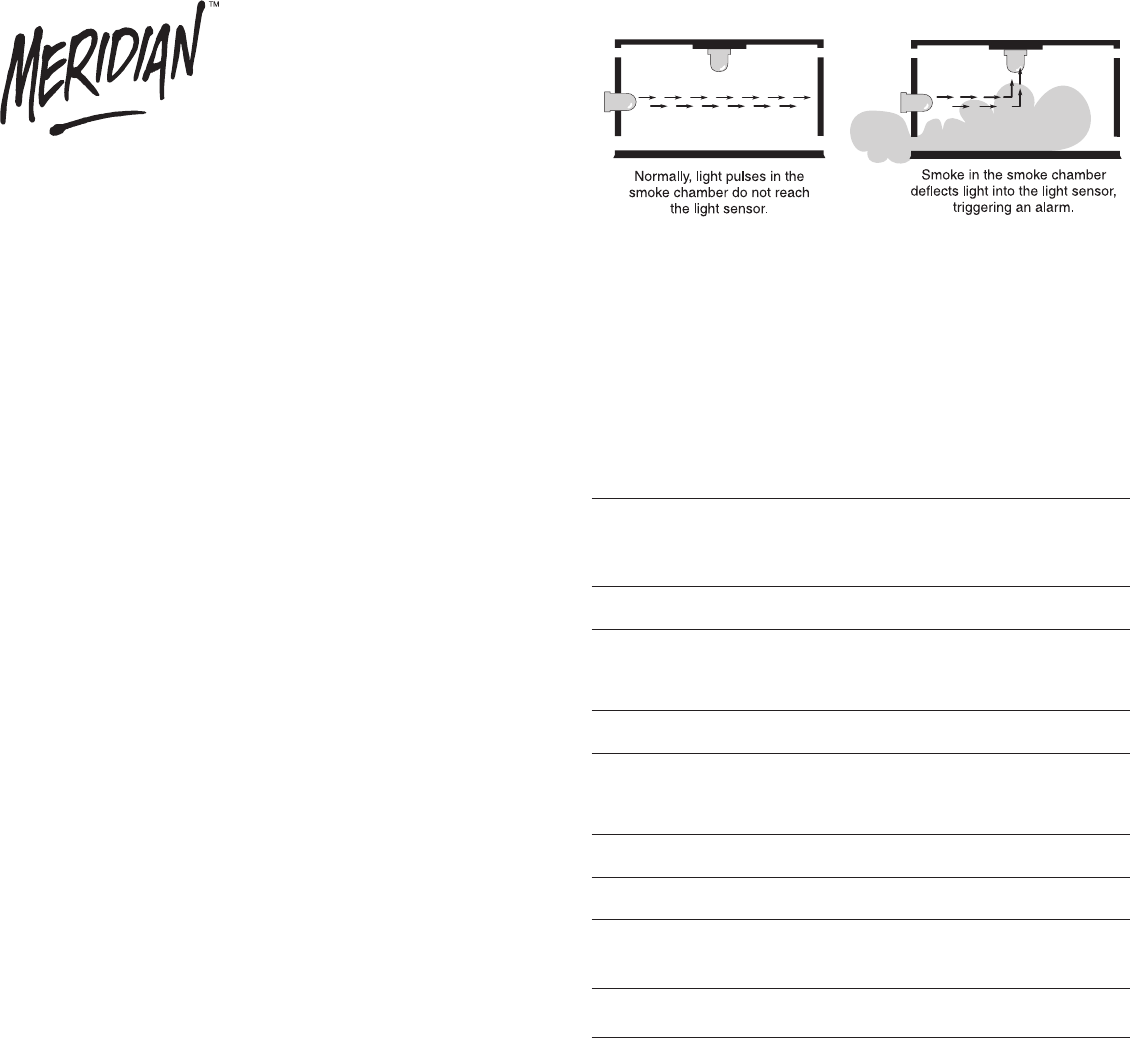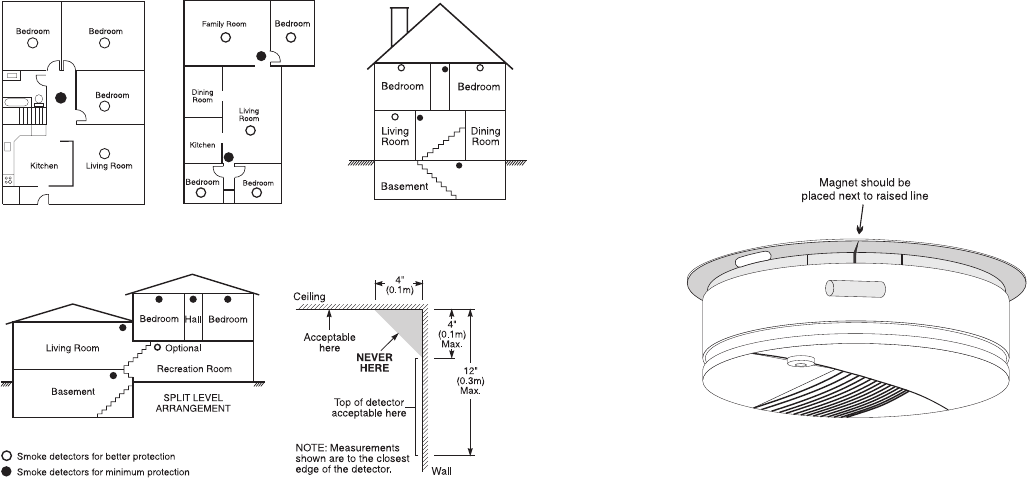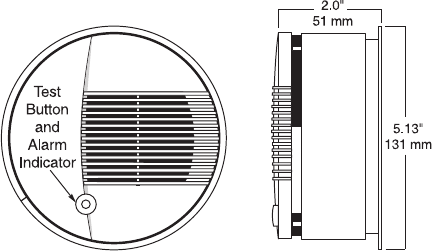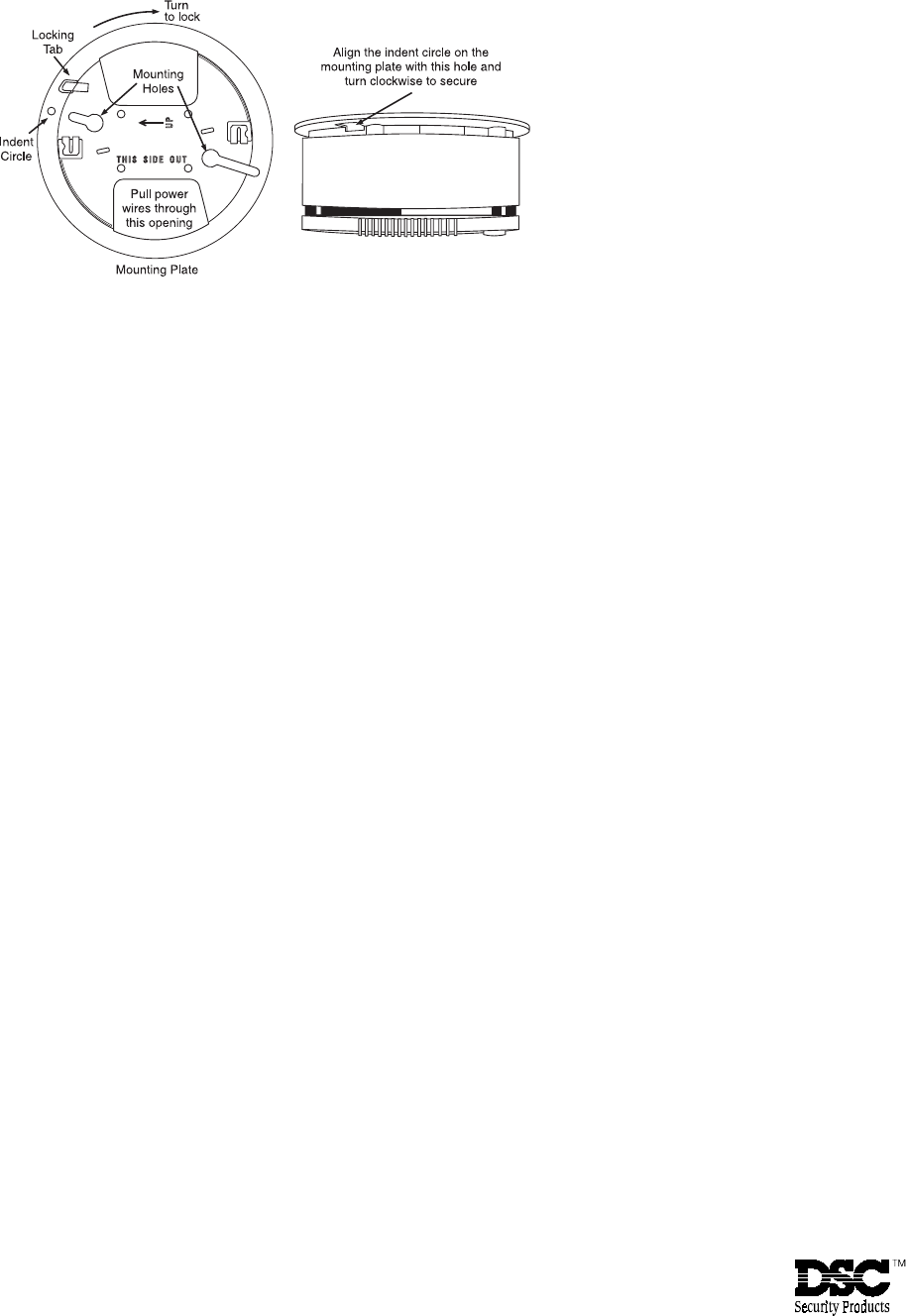Tyco Safety Canada 01LC906 WLS906-433, WLS906-433EU & WLS906-433NA SMOKE DETE User Manual wls906 433 inis eng 29004973 r002 P65
Digital Security Controls Ltd. WLS906-433, WLS906-433EU & WLS906-433NA SMOKE DETE wls906 433 inis eng 29004973 r002 P65
Installation manual

How the Smoke Detector Works
As shown in the illustration, a light source is directed across the
smoke chamber and is not normally reflected into the sensing
element. When smoke enters the chamber, the light beam is
scattered by the smoke and is reflected into the sensor. When
enough light is detected by the sensor, an alarm is activated. On
alarm, the sounder is activated and the red LED will flash.
When
the smoke clears from the smoke chamber, the unit will
automatically reset itself.
Alarm Indications
Condition Sounder Indicator RF
Light Transmission
No smoke Silent Flash every Supervision transmission
40-50 s every 12 min. for
Europe / every 64 min.
for North America
Smoke Alarm Flash every Alarm
0.67 s transmission
Automatic self test Silent Flash every Supervision transmission
functioning normally 40-50 s every 12 min. for
Europe / every 64 min.
for North America
Automatic self test Chirp between Flash every Fire Trouble
insufficient sensitivity LED flashes 40-50 s transmission
Push-button test Alarm Flash every Supervision transmission
functioning normally 0.67 s every 12 min. for
Europe / every 64 min.
for North America
Push-button test Silent Flash every Fire Trouble
insufficient sensitivity 40-50 s transmission
Magnet/reed switch Alarm Flash every Alarm
test functioning normally 0.67 s transmission
Magnet/reed switch Silent Flash every Fire Trouble
test insufficient 40-50 s transmission
sensitivity
Low battery Chirp simultaneous Flash every Fire Trouble
with LED flash 40-50 s transmission
Limitations of Smoke Detectors
While the Meridian smoke detector has been designed for reliability,
it is important to know that all smoke detectors have limitations.
• Smoke detectors will not work without power. If the batteries are
low, the smoke detector will not function. See ‘Battery Installation’
below for important information on battery use.
• Smoke detectors can only generate an alarm when smoke gets
inside the smoke chamber; anything that prevents smoke from
entering the smoke chamber may prevent or delay an alarm.
Refer to the ‘Guidelines for Locating Smoke Detectors’ on this
Instruction Sheet
; it is important that smoke detectors be located
on at least every floor of the premises, preferably in every room.
It is also important to avoid obstructions, such as closed doors,
that may prevent smoke from reaching the unit. A smoke detector
will not detect a fire in the walls, in the chimney or on the roof of
a building until smoke enters the smoke chamber.
READ THIS INSTRUCTION SHEET THOROUGHLY BEFORE
INSTALLING AND USING YOUR MERIDIAN SMOKE DETECTOR
Features
• Advanced 90° photoelectric detection pattern and specially
designed smoke chamber
∗∗
∗∗
∗
for superior detection and dust
resistance
• Unique high signal-to-noise ratio and superior RFI
immunity to prevent false alarms
• Excellent smoke access provides reliable detection for all
smoke flow directions and velocities
• Loud 85dB piezoelectric alarm horn
• Battery-powered design for easy installation and
independence from house power sources
• Uses six AA batteries and special circuit design to provide
extra long battery life
• Solid-state LED indicator light (red)
• Visible flash light and audible trouble chirp for low battery
warning
• Equipped with an RF transmitter, WLS906 can
communicate with compatible DSC Wireless Security
Systems
• Test Button allows user to perform sensitivity test and get
a local indication of test result
• Magnet-activated reed switch allows user to perform
system test
• Battery removal sensor alerts user to missing battery and
prevents installation of detector when no battery is
installed
• Automatic self-test once every 40 seconds provides an
audible trouble indication if the unit has insufficient smoke
sensitivity
• Attractive styling for any decor
∗∗
∗∗
∗
Protected under Canadian Patent No. 1452296. Other patents pending.
Introduction
The DSC Meridian photoelectric smoke detector incorporates
many advanced design features to provide years of reliable
operation. It is important to follow the installation and operation
instructions on this sheet to ensure that the unit will function
properly — even the best designed smoke detector will be rendered
useless if it is not connected or located properly.
It is very important that you understand how to test and maintain
your system. Read the
Instruction
or
User Manual
for your alarm
system to familiarize yourself with the fire alarm functions. Be sure
to test your system regularly following the test procedures described
in your manual. If you should ever have problems operating or
testing your system, and especially if there are problems with the
fire alarm functions, contact your smoke detector installer or dealer
immediately for service.
While smoke detectors and alarm systems are designed to warn you of
potentially dangerous situations, no system can prevent emergencies.
An alarm system is not a substitute for life and property insurance; you
should always maintain appropriate insurance coverage.
WLS906-433
Battery-Powered Smoke Detectors
For Residential Use
INSTRUCTIONS FOR
INSTALLATION AND USE

• Smoke detectors have certain obvious limitations: they may not
provide protection for someone smoking in bed, for children
playing with matches, or for sudden and violent explosions. A
smoke detector is a single part of overall fire safety precautions;
the smoke detector should never be seen as a substitute for a
complete fire safety program.
Guidelines for Locating Smoke Detectors
On smooth ceilings, detectors may be spaced 9.1m (30 feet) apart
as a guide. Other spacing may be required depending on ceiling
height, air movement, the presence of joists, uninsulated ceilings,
etc. Consult National Fire Alarm Code NFPA 72, CAN/ULS-S553-
M86 or other appropriate national standards for installation
recommendations.
Do not locate smoke detectors at the top of peaked or gabled
ceilings; the dead air space in these locations may prevent the unit
from detecting smoke.
Avoid areas with turbulent air flow, such as near doors, fans or
windows. Rapid air movement around the detector may prevent
smoke from entering the unit.
Do not locate detectors in areas of high humidity.
Do not locate detectors in areas where the temperature rises
above 38oC (100oF) or falls below 5oC (41oF).
Smoke detectors should always be installed in accordance with
NFPA 72, the National Fire Alarm Code. Smoke detectors should
always be located in accordance with:
• Paragraph 2-2.1.1.1 of NFPA 72, Chapter 2.:
“Smoke detectors
shall be installed outside of each separate sleeping area in the
immediate vicinity of the bedrooms and on each additional story
of the family living unit, including basements and excluding crawl
spaces and unfinished attics. In new construction, a smoke
detector also shall be installed in each sleeping room.”
• Paragraph 2-2.1.1.2 of NFPA 72, Chapter 2.:
“Split level
arrangement. Smoke detectors are required where shown. Smoke
detectors are optional where a door is not provided between
living room and recreation room.”
Testing Your Smoke Detector
Follow the test procedure described here or contact your
smoke detector dealer or installer for testing instructions.
It is recommended that your entire alarm system be tested at
least once per week to verify the operation of all system
functions.
Smoke Detector Unit Test
To test the smoke detector, press and hold the test button on the
front of the unit. When the button is pressed, the unit’s alarm should
sound. When the button is released, the alarm should be silenced.
If this does not occur, check that the batteries are the correct type,
in good condition and are installed correctly (see the
‘
Battery
Installation’ section below).
Upon completing the functional testing of the smoke detector,
check the unit’s sensing chamber to ensure proper operation. To
test the sensing chamber, waft a lit cotton wick or punk stick
around the outside of the unit until a generous amount of smoke
enters the sensing chamber, or the unit alarms. If the smoke
detector does not function properly, call your smoke detector
installer or dealer for service.
System Test
To prepare your alarm system for a complete test, refer to the testing
instructions section of your system’s manual.
Observe carefully all
instructions regarding notification of the monitoring station in
order to avoid an unnecessary emergency response.
When the
system is ready to be tested, hold the test magnet against the smoke
detector case as shown below.
After activating the smoke detector’s system test, an alarm should
sound and the indicator light should flash every 0.67 seconds.
When the magnet is removed, the alarm should be silenced.
See
your system manual for further instructions regarding
completion of the alarm system test.
Owner’s Maintenance Instructions
The Meridian smoke detector is designed to require a minimum of
maintenance. If the case becomes dusty, wipe the case gently with
a soft dry cloth. If the case is greasy, wipe the case gently with a soft
cloth slightly dampened with soapy water.
Never disassemble the smoke detector; there are no user
serviceable parts inside the unit. Never paint the unit, as paint
may prevent smoke from entering the unit. If you are planning
renovations or repainting, contact your installer and ask that
the unit be temporarily removed until work is complete.
If the unit is located in an area where it is exposed to high levels of
dust or insects and is found to cause false alarms, it may require
service; contact your smoke detector installer or dealer.

Fire Safety In The Home
Most fires occur in the home, and to minimize this danger, it is
recommended that a household fire safety audit be conducted and
a family escape plan be developed.
Household Fire Safety Audit
1 Are all electrical appliances and outlets in a safe condition?
Check for frayed cords, overloaded lighting circuits, etc. If you
are uncertain about the condition of your electrical appliances or
household service, have a professional evaluation.
2 Are all flammable liquids stored safely in closed containers in a
cool, well ventilated area? Cleaning with flammable liquids
should be avoided.
3 Are hazardous materials such as matches out of the reach of
children?
4 Are furnaces and wood burning appliances properly installed,
clean and in good working order? If in doubt, have a professional
evaluation.
Family Escape Planning
There is often very little time between the detection of a fire and the
time it becomes deadly. Because of this, it is very important that a
family escape plan be developed and rehearsed.
1 Every family member should participate in developing the
escape plan.
2 Study the possible escape routes from each location within the
house. Since many fires occur at night, special attention should
be given to the escape routes from sleeping quarters.
3 It is essential that escape from a bedroom be possible without
opening the interior door. Consider the following when making
your escape plans:
• Make sure that doors and windows that open to the outside are
easily opened. Ensure that they are not painted shut, and that
their locking mechanisms operate smoothly.
• If opening the exit or using the exit is too difficult for children, the
elderly or handicapped, plans for rescue should be developed.
This includes making sure that those who are to perform the
rescue can promptly hear the fire warning signal.
• If the exit is above the ground level, an approved fire ladder or
rope should be provided, as well as training in its use.
• Exits on the ground level should be kept clear. Be sure to remove
snow from exterior patio doors in winter; outdoor furniture or
equipment should not block exits.
• The family should have a predetermined assembly point where
everyone can be accounted for; for example, across the street or
at a neighbour’s house.
• Once everyone is out of the house, call the Fire Department.
• A good plan emphasizes quick escape. Do not investigate first
or attempt to fight the fire, and do not attempt to rescue belongings
or valuables as this takes up time. Once outside, do not re-enter
the house; wait for the fire department.
• Write the plan down and rehearse frequently so that should an
emergency arise, everyone will know what to do. Revise the plan
as conditions change; for example, when there are more or fewer
family members in the home, or if there are changes to the house.
• Make sure your fire warning system is operational by conducting
weekly tests. If you are unsure about system operation, contact
your smoke detector installer or dealer.
• It is recommended that you contact your local fire department
and request further information on home fire safety and escape
planning. If available, have your local fire prevention officer
conduct an in-house fire safety inspection.
Enrolling a WLS906
On the back of the smoke detector housing, there will be a five digit
and/or six digit serial number. Please refer to your receiver installation
manual for information on which serial number should be enrolled.
NOTE: If using a WLS900 system, you must use the 5 digit serial
number.
Installation Instructions
Specifications
Operating Voltage ......................9V (six AA alkaline batteries)
Smoke Sensitivity .................................................. 2.3±0.5 %/ft
Ambient Installation Operating Range
......................................................32°F - 100°F / 0°C - 37.8°C
............................................... 5% - 95% RH, non-condensing
Field Test ............ Magnet-activated reed switch or pushbutton
............................. and Gemini 501 Smoke Detector Analyser
Dimensions
Battery Installation
Remove the mounting plate from the detector by pushing the
locking tab and turning the mounting plate counter-clockwise.
Hold the unit with the battery compartment facing you, and the
imprinted wording right-side up. Install the first two batteries in the
row nearest to you, with the + terminals facing left. Next, install the
middle two batteries with the + terminals facing to the right. Place
your thumb over the centre of these four batteries to keep them in
place. Install the last two batteries, with their + terminals facing
to the left, by snapping them past the nylon retainer.
Use six AA Alkaline Energizer E91, or Duracell MN1500 batteries.
Do not use other brands of batteries for the smoke detector.
Using brands other than the Energizer E91 or Duracell MN1500
may affect the operation of the system. Batteries may be
purchased in supermarkets and hardware stores.

Mounting the Unit
Locate the smoke detector mounting plate on the wall or ceiling and
mark all desired screw locations. Use the supplied wall anchors for
all screw locations. When the anchors have been placed, secure
the mounting plate to the ceiling or wall.
To place the smoke detector on its mounting plate, align the
mounting plate's locking tab with the lock recess on the case and
turn the unit clockwise until it is firmly secured.
THIS EQUIPMENT SHOULD BE INSTALLED IN ACCORDANCE
WITH THE NATIONAL FIRE PROTECTION ASSOCIATION’S
STANDARD 72. (National Fire Protection Association, Batterymarch
Park, Quincy, MA 02269)
Dust Cover
The dust cover is intended to protect the unit from dust and dirt
entry, only while the unit is not in service.
CAUTION: The smoke detector will not function with the dust
cover in place.
Installer’s Maintenance Instructions
Normally, the Meridian smoke detector will not require maintenance.
If the unit is mounted in a dusty environment, the inlet areas of the
case should be wiped gently with a soft, dry cloth.
Be sure to inform the user and their monitoring station when
maintenance of any sort is performed on the smoke detector or any
part of the alarm control system. Always test smoke detectors after
maintenance. If a smoke detector continues to generate nuisance
alarms even after maintenance, return the unit to DSC for service.
Contact DSC at the address and number below to obtain a return
authorization number before returning the unit.
Installer’s Responsibility to the User
It is the installer’s responsibility to thoroughly instruct the end user
of the system on the operation, testing and maintenance of their
system. The installer should fully explain and demonstrate all
functions of the alarm control system and any equipment, such as
smoke detectors, connected to it. The user should be provided with
all instruction sheets and manuals for their system and any
components connected to it. Complete and thorough instruction
for the user is essential to ensure they will obtain the greatest
benefit from their system. Providing the user with complete
operational information will also benefit the installer through a
reduction in service calls for nuisance alarms.
Limited Warranty
Digital Security Controls Ltd. warrants that for a period of twelve months from the
date of purchase, the product shall be free of defects in materials and workmanship
under normal use and that in fulfilment of any breach of such warranty, Digital
Security Controls Ltd. shall, at its option, repair or replace the defective equipment
upon return of the equipment to its repair depot. This warranty applies only to defects
in parts and workmanship and not to damage incurred in shipping or handling, or
damage due to causes beyond the control of Digital Security Controls Ltd. such as
lightning, excessive voltage, mechanical shock, water damage, or damage arising
out of abuse, alteration or improper application of the equipment.
The foregoing warranty shall apply only to the original buyer, and is and shall be in
lieu of any and all other warranties, whether expressed or implied and of all other
obligations or liabilities on the part of Digital Security Controls Ltd. Digital Security
Controls Ltd. neither assumes, nor authorizes any other person purporting to act on
its behalf to modify or to change this warranty, nor to assume for it any other warranty
or liability concerning this product.
In no event shall Digital Security Controls Ltd. be liable for any direct, indirect or
consequential damages, loss of anticipated profits, loss of time or any other losses
incurred by the buyer in connection with the purchase, installation or operation or
failure of this product.
Smoke detectors that are a part of this system may not properly alert occupants of a
fire for a number of reasons, some of which follow. The smoke detectors may have
been improperly installed or positioned. Smoke may not be able to reach the smoke
detectors, such as when the fire is in a chimney, walls or roofs, or on the other side of
closed doors. Smoke detectors may not detect smoke from fires on another level of the
residence or building.
Every fire is different in the amount of smoke produced and the rate of burning. Smoke
detectors cannot sense all types of fires equally well. Smoke detectors may not provide
timely warning of fires caused by carelessness or safety hazards such as smoking in
bed, violent explosions, escaping gas, improper storage of flammable materials, over-
loaded electrical circuits, children playing with matches or arson.
Even if the smoke detector operates as intended, there may be circumstances when
there is insufficient warning to allow all occupants to escape in time to avoid
injury or death.
Warning: Digital Security Controls Ltd. recommends that the entire system be
completely tested on a regular basis. However, despite frequent testing, and due to, but
not limited to, criminal tampering or electrical disruption, it is possible for this
product to fail to perform as expected.
Important Information: Changes or modifications not expressly approved by Digital
Security Controls Ltd. could void the user’s authority to operate this equipment.
FCC Compliance Statement
CAUTION: Changes or modifications not expressly approved by Digital Security
Controls Ltd. could void your authority to use this equipment.
This equipment generates and uses radio frequency energy and if not installed and used
properly, in strict accordance with the manufacturer’s instructions, may cause interfer-
ence to radio and television reception. It has been type tested and found to comply with
the limits for Class B device in accordance with the specifications in Subpart “B” of Part
15 of FCC Rules, which are designed to provide reasonable protection against such inter-
ference in any residential installation. However, there is no guarantee that interference
will not occur in a particular installation. If this equipment does cause interference to
television or radio reception, which can be determined by turning the equipment off and
on, the user is encouraged to try to correct the interference by one or more of the following
measures:
•Re-orient the receiving antenna
•Relocate the alarm control with respect to the receiver
•Move the alarm control away from the receiver
•Connect the alarm control into a different outlet so that alarm control and receiver are
on different circuits.
If necessary, the user should consult the dealer or an experienced radio/television techni-
cian for additional suggestions. The user may find the following booklet prepared by the
FCC helpful: “How to Identify and Resolve Radio/Television Interference Problems”.
This booklet is available from the U.S. Government Printing Office, Washington, D.C.
20402, Stock # 004-000-00345-4.
For more information and technical assistance:
© 2000 Digital Security Controls Ltd.
Toronto, Canada • www.dscgrp.com
Printed in Canada 29004973 R002